1. Birth and Baptism 1838
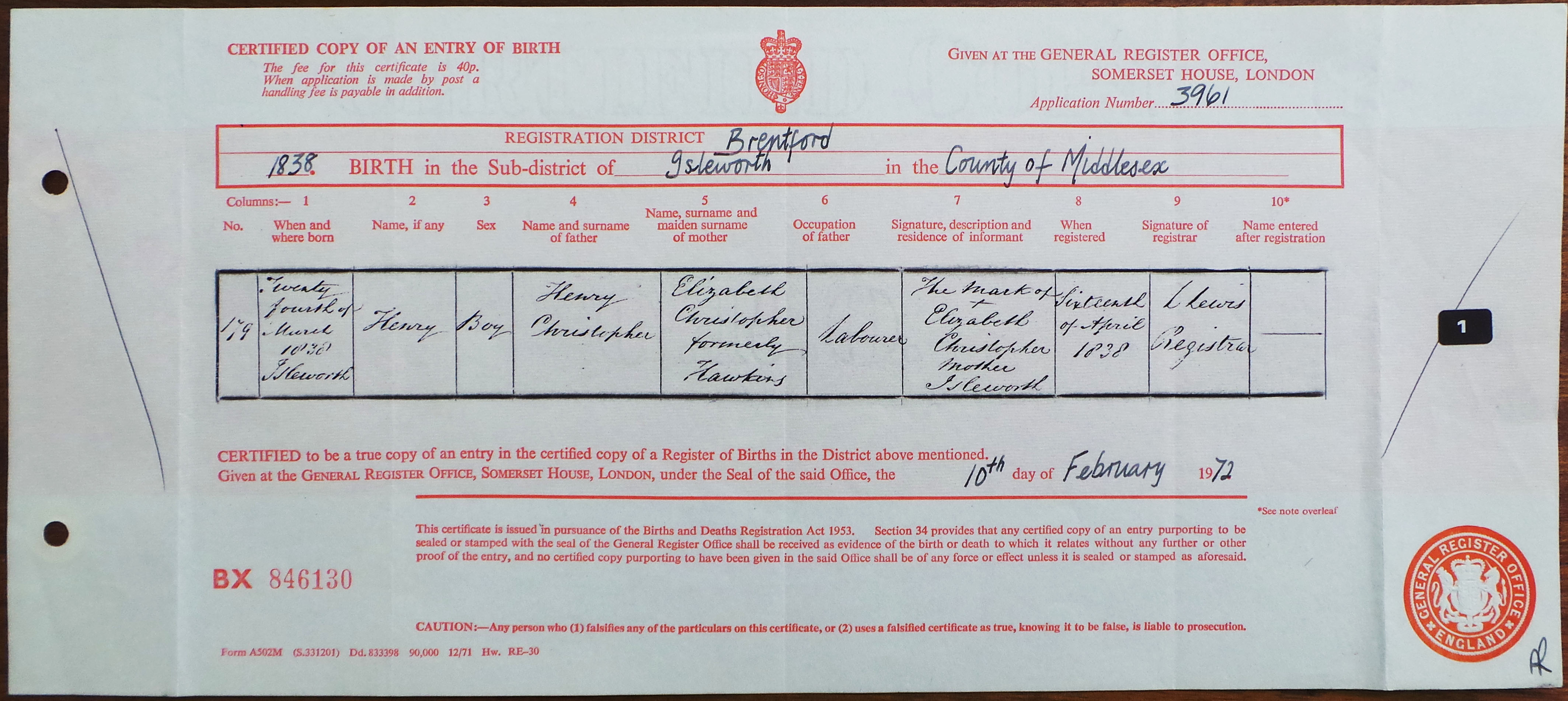
Henry CHRISTOPHER Junior (1838-1914) was my maternal (2x) great grandfather, and was born at the dawn of a new age brought about by the advent of the Railways.
Henry first saw the light of day on 24th March 1838 in the parish of Isleworth in Middlesex. His 24 year old father and 18 year old mother had him baptised on 22nd April 1838 at the parish church of All Saints where they had married the year before.
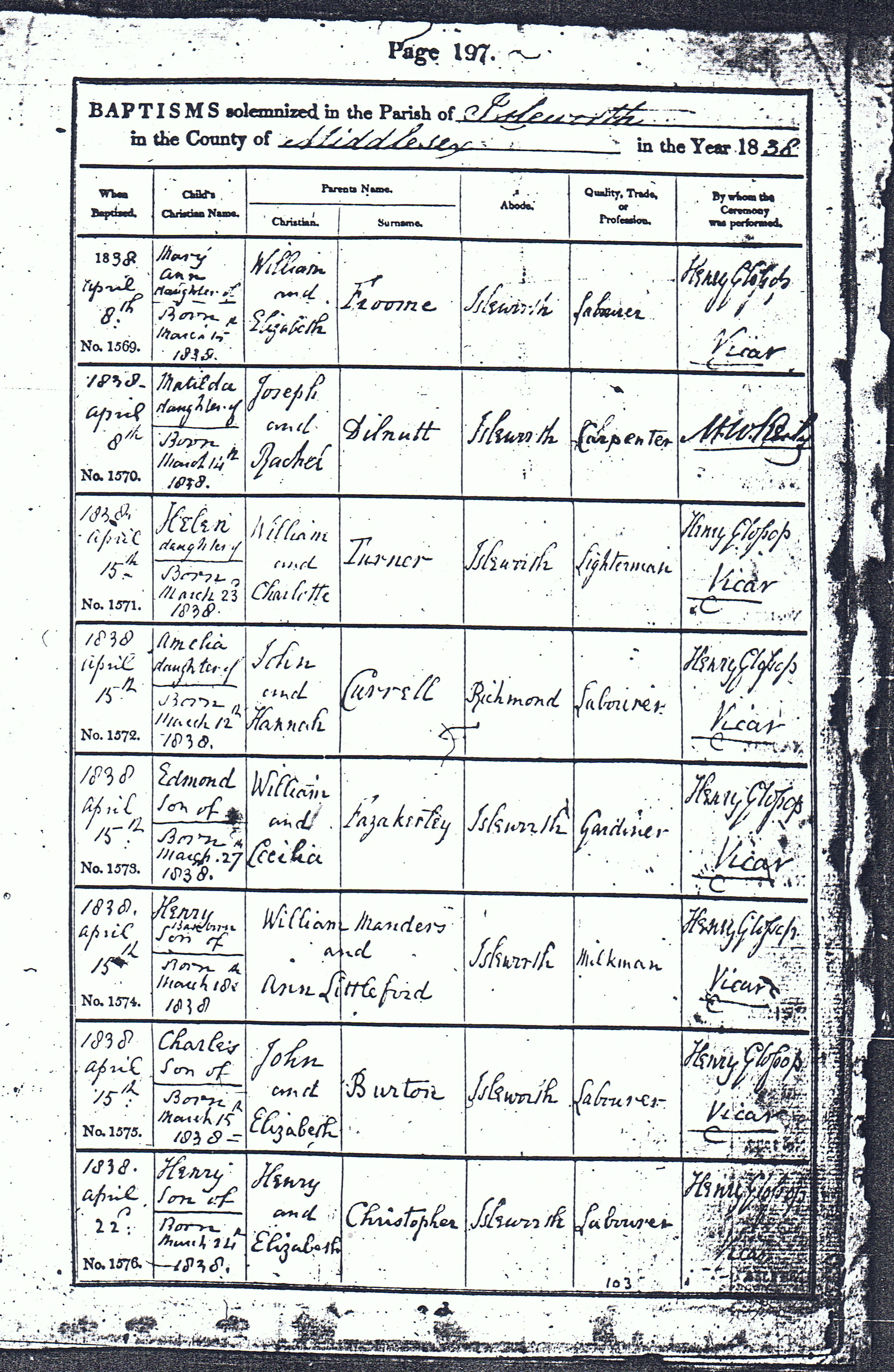 The ceremony was carried out by the resident vicar of All Saints the Rev Henry Glossop MA (1780-1869) a graduate of Corpus Christie in Cambridge who had been vicar there since 1821. Although the painting above was done some 20 years later it was very much the scene that greeted him that day with the ferry running across the Thames from the steps in front of the church to old Deer Park. Little did he know that he was the first of their 10 children. The ceremony was carried out by the resident vicar of All Saints the Rev Henry Glossop MA (1780-1869) a graduate of Corpus Christie in Cambridge who had been vicar there since 1821. Although the painting above was done some 20 years later it was very much the scene that greeted him that day with the ferry running across the Thames from the steps in front of the church to old Deer Park. Little did he know that he was the first of their 10 children.
His father had been working as a labourer helping to construct the London and Southampton Railway (LRS) line and only a month after Henry's baptism the first 23 mile section of the line officially opened to passenger traffic. This section of line ran from it's terminus at 'Nine Elms' and passed just 4 miles south of where they lived at Isleworth going on to Woking Common. This was such a great occasion that I like to think the whole family if not the whole village would have gathered to watch the 5 passenger trains travel each way along the line that day, a journey that took 57 minutes. By the end of the first week 93,795 passengers had traveled on the line which demonstrates the level of interest in this new development from the very outset.
For some time now the whole of London had been in turmoil because of railway development. Whole areas of slums were eventually demolished and high embankments constructed to bring the railways into the very heart of the City. On 4th June 1838 only two weeks after The LSR opened it's first section of line, Isambard Kingdom Brunel (1806-1859) opened the first section of the Great Western Railway (GWR) (running from Paddington to Maidenhead). On 17th September 1838 Robert Stevenson (1803-1859) joined the others by opening the first section of line of the London to Birmingham Railway which ran north from Euston station.
The families involvement in these projects and the early years of Henry's childhood have already been covered in my account of the life of his father Henry Christopher Senior (1814-1865) which can be accessed via this link so I will not repeat them here.
Henry's childhood therefore saw him move with his parents in 1841 to follow the construction of the Eastern Counties Railway. During his youth he was to move four times living at Ridden Court in Hornchurch, followed by Great Warley and Colchester all in Essex, and onto Thurston in Suffolk.
He lived in Thurston from the age of 10 where his father was employed as a platelayer repairing the railway track. He probably left around the age of 18 and appears to have traveled back down the Railway line to Chelmsford and worked as a Hawker. In fact I am fairly sure he was traveling around the area selling the shoes made by George Keys (1810-1892) a local cordwainer, which is how he came to meet his daughter Mary Ann Keys.
Mary Ann Keys (1835-1914) was
born on 5th and baptised in All Saints Church on the 9th August 1835 in the small village of Purleigh which is situated about 4 miles south of Maldon on the Blackwater Estuary in Essex. She was the eldest child of George Keys (1810-1892) a shoemaker by trade by his 2nd wife Phoebe More (1811-1875) and baptised at the local parish church of All Saints on the 9th of the same month.
She was later joined by five younger siblings born between 1835 and 1850. From Purleigh the family moved about 1840 to live at Woodham Walter a small village just 2 miles west of Maldon where her father was able to sell his shoes.
By 1844 the family had moved another 2 miles west towards Chelmsford to the the next village of Little Baddow and by 1847 were living just a mile south east of Chelmsford at Great Baddow. They were still there in 1851 but by then Mary was 16 years old and had found employment working at Boreham Mill
on the river Chelmer on the other side of Chelmsford. Here she was working as a house maid for the miller Arthur Muggeridge and his wife Jane.
2. Marriage at St John's Church in Moulsham, Chelmsford - 1858
Henry Christopher Junior and Mary Ann Keys were married by the Rev Christopher Ralph Muston (1796-1859) the perpetual curate of St John's church in Moulsham on 22nd June 1858. The church had been consecrated on 11th April 1837 as a small rectangular chapel surprisingly with a seating capacity of 550. With it's new found independence from Chelmsford on the other side of the river however it soon became apparent that a much larger church was needed, and the south transept was added in 1851. The north transept was not added until 1874 and the tower not until 1884 so it was very different in appearance from that seen today when they married there in 1858.
Henry who was 20 years old, and therefore classified as a minor, needed his parents permission to marry, whilst Mary who was 2 years older is recorded as being of full age. The marriage witnesses were both her parents. Sadly the Rev Muston died the following year.
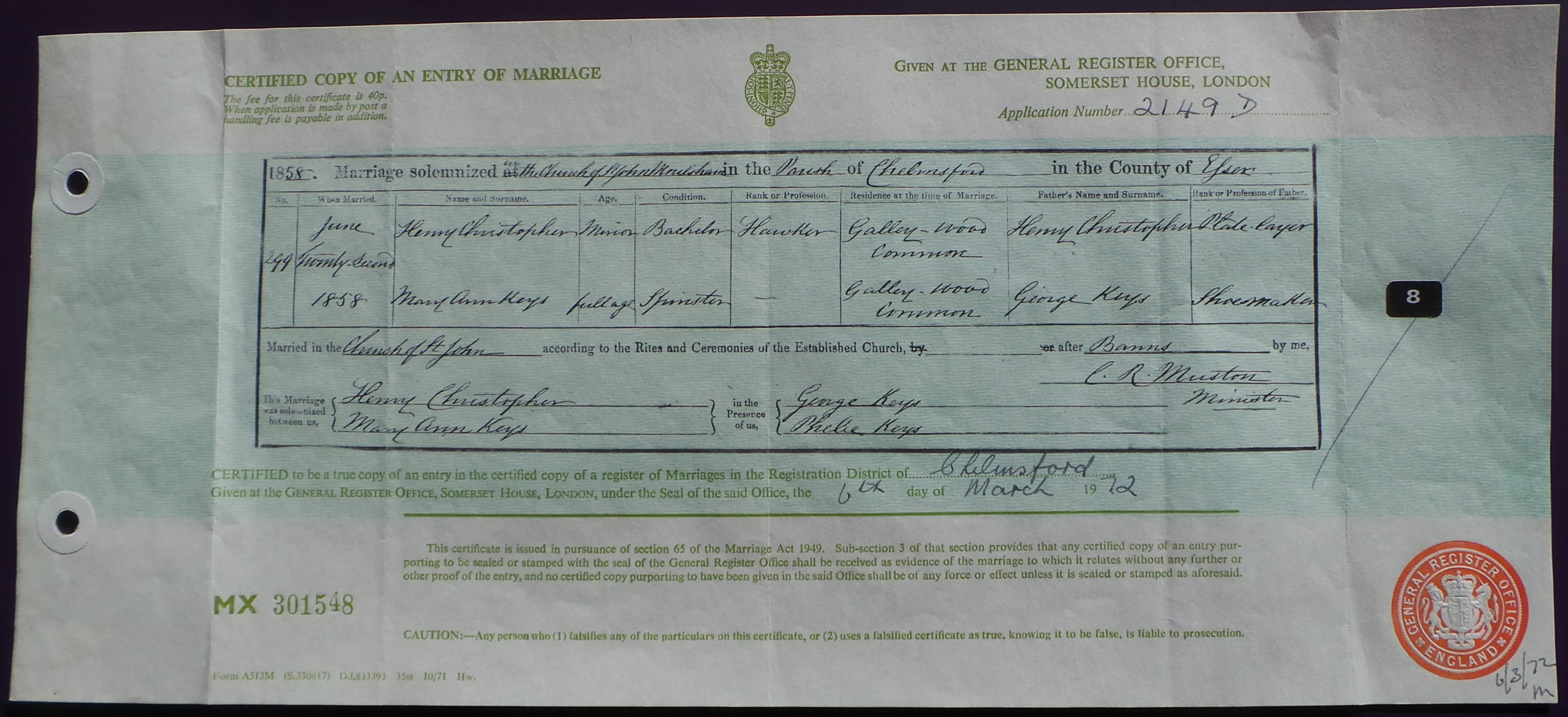
When Henry’s father worked in Colchester in the mid 1840’s they came into contact with another Railway Family by the name of Mayne. The father Robert George Mayne (b.1817) was a baptised in Swanborne in Buckinghamshire and like so many at that time had been drawn into London by the advent of Railway development to become an engineer. He was simply known as George Mayne throughout his life originally to to distinguish him from his father Robert Mayne a butcher by trade. George had married at Hoxton near Hackney in London to Susannah Watling the daughter of Richard Watling a sawyer by trade in 1842 but she was a native of Rayleigh in Essex. After marriage like the Christopher family George found employment working for the Eastern Counties Railway at Colchester. All their older children were born there. Around 1854 the family moved to Maldon, and when her children grew up it was natural for the boys to look for work on the Railways. By 1859 George Mayne her eldest son was an Engine Driver and working at the Stratford main Railway depot.
About this time Joseph Christopher (1813-1867) who was Henry Christopher junior’s uncle, also secured a job working with George Mayne at the same depot and he moved his family from Ipswich to live right next to the depot at number 5 Dorset Place. Joseph’s eldest son David Taylor Christopher was by now 20 years old and he started working with John Denman, who was a journeyman blacksmith. When Henry Christopher junior married Mary Ann Keys he left Chelmsford to also work with John Denman and they moved in with David who was living in the next street at Alfred Terrace.
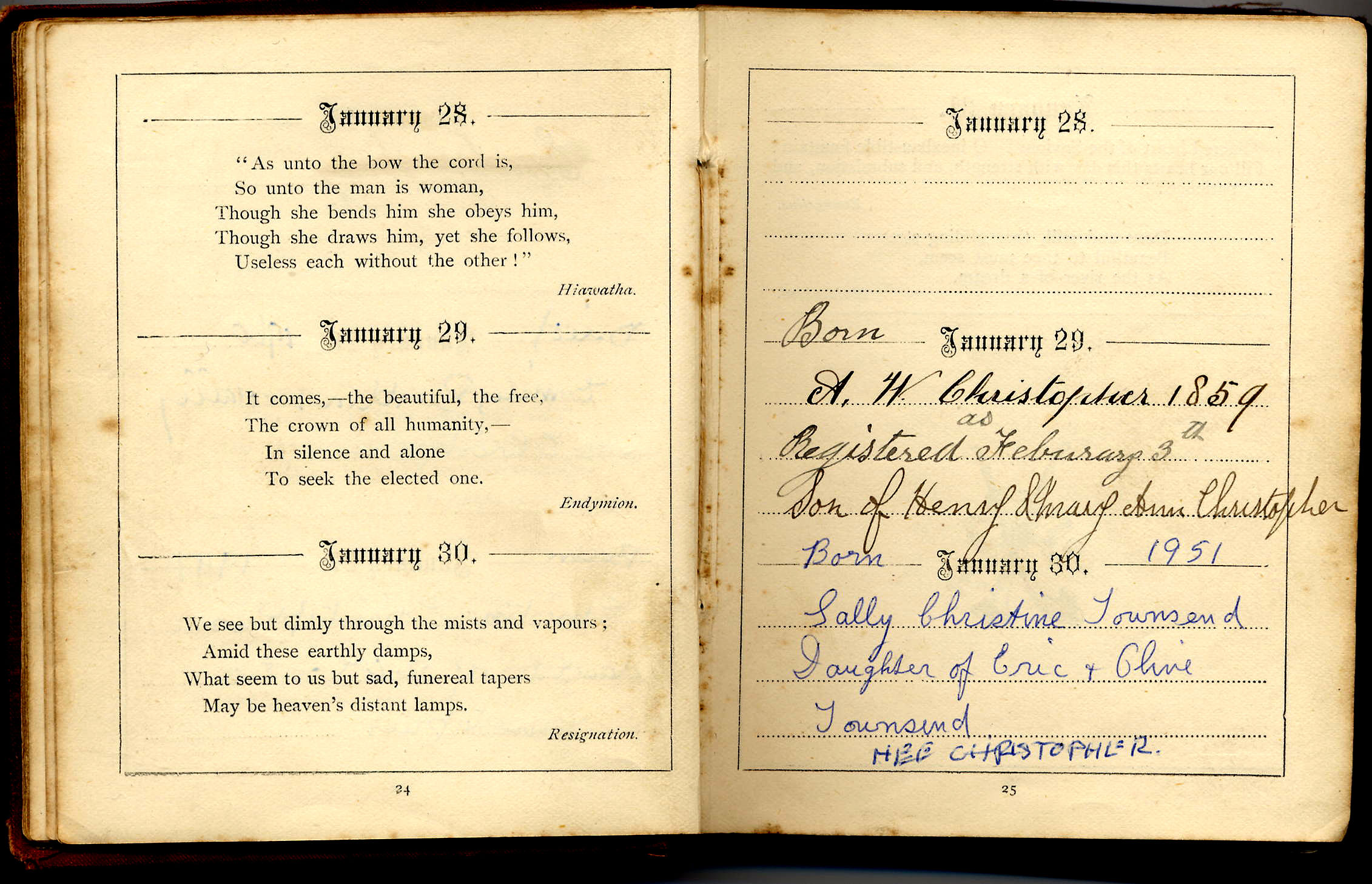 3. Birth of Arthur William CHRISTOPHER - 1859
3. Birth of Arthur William CHRISTOPHER - 1859
Henry and Mary Ann’s first child Arthur William Christopher entered this world on 29th January 1859 and many years later Arthur recorded his own birth date in the 'Longfellow Text Book' which Arthur used to record all the families birthdays (see image left). Underneath his entry in the handwriting of my great grandmother Catherine Lucy Denman are the words “Registered as February 5th.”
According to my great aunt this was because Mary took some time to recover from the birth and they omitted to register it until 14th March. Although the Act of Parliament made registration of births compulsory here was no penalty for non registration. It was only free however for a period of 6 weeks after birth, so they needed another date within the 6 weeks, but close to the real date of birth. They chose the 5th February the birth day of John Denman's daughter Catherine Lucy who had been born two years earlier. From that day fate decreed that they would eventually marry and Arthur, like the Queen, had a real and official birth day.
1859 was to prove an eventful year for both families. At the same time as Arthur was being born his father's 18 year old niece Mary Ann Taylor Christopher (1841-1867) (the younger sister of David Taylor Christopher) became romantically involved with George Mayne and was pregnant by April. She gave birth to an illegitimate boy on 31st January 1860 in their house in Alfred Terrace and called him George Frederick Mayne.
As explained in the account of the life of Henry Christopher Senior, John Denman's wife Elizabeth DENMAN (1822-1859) was also pregnant with their 5th child. Clearly the birth did not go well for she died at the age of 37 on 14th May 1859 -- just 7 days after giving birth to a baby boy they named Joseph Denman (1859-1864). Her death certificate gives the cause of death as "Childbirth/Peritonitis 7 days" and I have little doubt that Mary Ann (Henry Christopher junior's wife), who was already nursing her own 3 month old son, stepped into the breach and temporarily looked after Joseph as well. Once weaned the decision was then taken to send Joseph to live at Ardleigh in Essex with his maternal grandparents Samuel & Susan James.
This was also the year that Henry’s parents moved to live in West Ham, settling just the other side of the Railway track at 4 Nursery Terrace. Henry’s mother gave birth to their last child Lavinia Christopher in April 1860 but any initial elation at this event was soon cut short when on the 21st May Charles Christopher, Henry’s teenage brother, died of Typhoid which he had caught from using polluted water to clean the Railway Engines at Stratford Depot. When Elizabeth caught pneumonia and also died on 13th March 1861 there really was no alternative to Mary moving into 4 Nursery Terrace to help look after the baby Lavinia and her husbands other younger siblings. So a month later when the 1861 Census was taken we find Henry Christopher Senior (1814-1865) living in the house with his 8 surviving children, his daughter-in-law and grandchild.
4. Move to Sydenham in Kent (1862-1864)
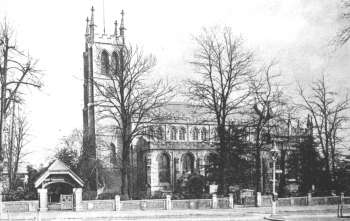 I have not been able to locate any records that directly relate to Henry CHRISTOPHER Senior during these three years but various documents recorded shortly after his death refer to him being a carpenter. We know that his son and daughter in law were living with him as Mary Ann was taking care of his younger children, and it's clear from her children's birth and baptism certificates that Henry Christopher Junior was employed on the Railways as an engine driver and that by the end of 1862 they were living at Wells Road in Sydenham Kent. Their second child Eliza Ellen CHRISTOPHER (1862-1863) was born at 'Edney Street' on 'Wells Road' on 23rd Dec 1862 . Edney Street is gone now but used to run along the north side of what is now 'Sydenham Wells Park' . The north boundary of the park is shown on modern maps running along 'Wells Park Road' which was simply called 'Wells Road' prior to the park being opened to the public in 1901. I have not been able to locate any records that directly relate to Henry CHRISTOPHER Senior during these three years but various documents recorded shortly after his death refer to him being a carpenter. We know that his son and daughter in law were living with him as Mary Ann was taking care of his younger children, and it's clear from her children's birth and baptism certificates that Henry Christopher Junior was employed on the Railways as an engine driver and that by the end of 1862 they were living at Wells Road in Sydenham Kent. Their second child Eliza Ellen CHRISTOPHER (1862-1863) was born at 'Edney Street' on 'Wells Road' on 23rd Dec 1862 . Edney Street is gone now but used to run along the north side of what is now 'Sydenham Wells Park' . The north boundary of the park is shown on modern maps running along 'Wells Park Road' which was simply called 'Wells Road' prior to the park being opened to the public in 1901.
Eliza Ellen and her elder brother Arthur William were baptised together at nearby St Bartholomew's church on 31st May 1863 (picture right). St Bartholomew's was erected in 1830 and within easy walking distance of where they lived. Later that year Mary Ann returned to her parents in Woodham Ferris in Essex for a short period. This may have been because her daughter Eliza Ellen was not well as she died there on the 17th of August 1863 although the cause of death is strangely given as 'convulsions from teething". Eliza was buried in the churchyard of St Mary the Virgin at Woodham Ferris on the 23rd.
They returned to live on Wells Road in Sydenham and on 7th Aug 1864 Mary Ann gave birth to their 3rd child Joseph Henry CHRISTOPHER (1864-1865) at 16 Fir Street and he too was baptised at St Bartholomew's church on 27th November 1864.
5. The Ottoman Railway Company (ORC) & Mr John Turtle Wood (1821-1890)
Discoveries at EPHESUS in TURKEY
View of the excavations picture taken December 1871 published 1877
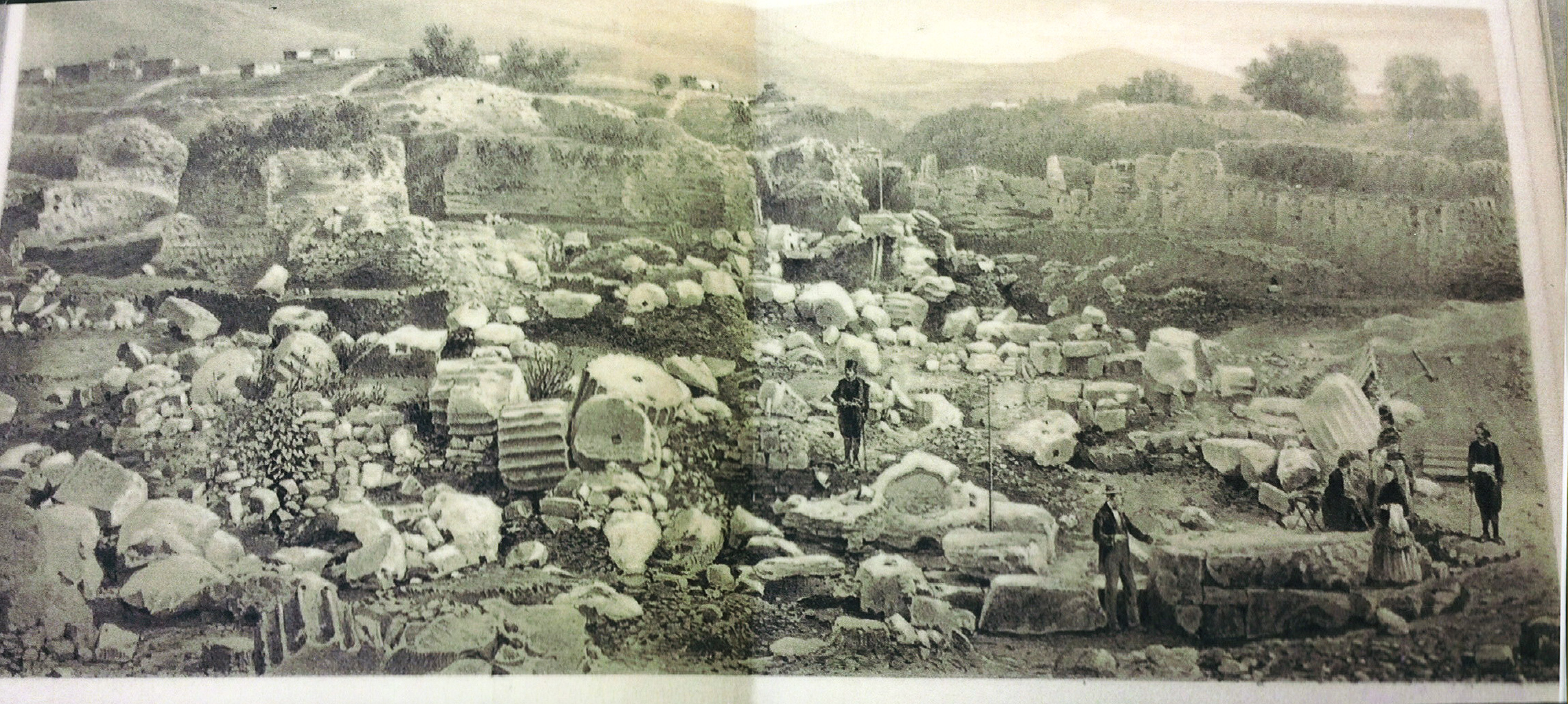
I have already related under the account of his fathers life how the Christopher Family set off for Turkey around December 1864 and provided background to the formation of the Ottoman Railway Company and the construction of the first section of railway line from Smyrna to Asasalouk and on to Ephesus Pass. I have provided a link to this account as it also covers the death in 1865 from Cholera of their youngest son Joseph Henry CHRISTOPHER(1864-1865) and Henry's father Henry CHRISTOPHER Senior (1814-1865) in Ephesus Pass in Turkey.
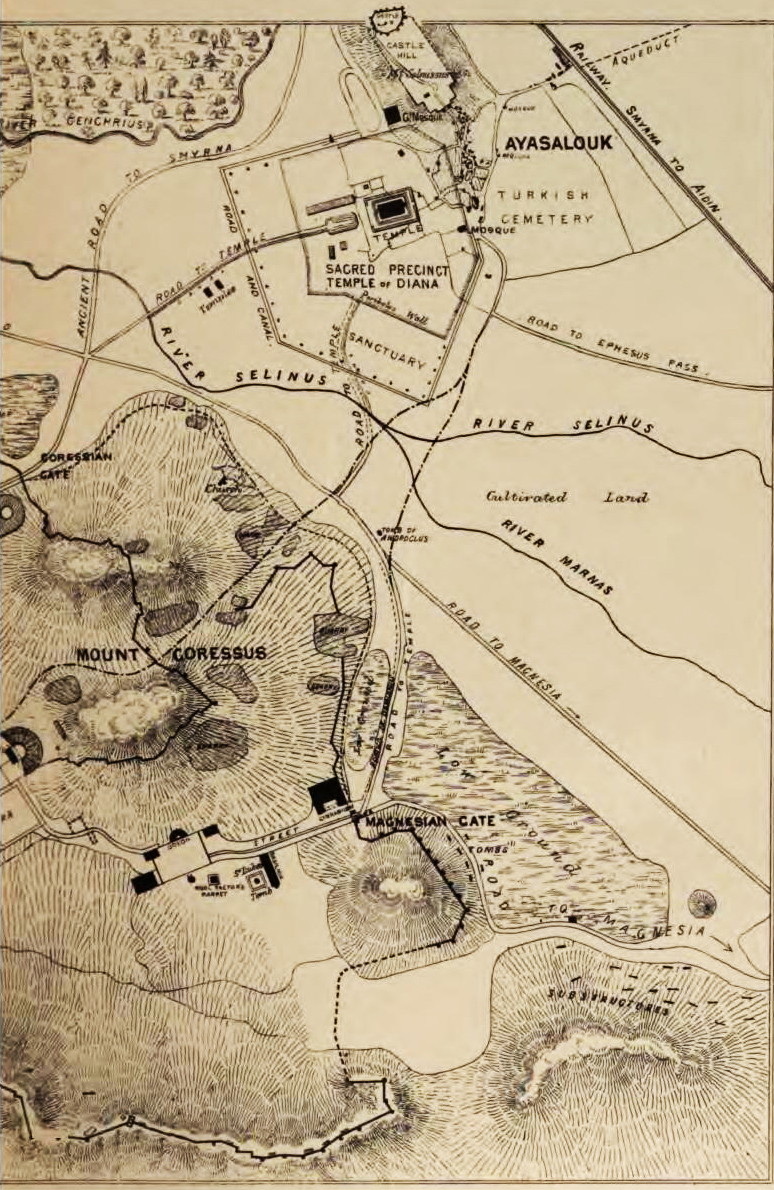 In the twilight of her life my great aunt Minnie Amelia Christopher (1894-1972) broke her hip and on the many visits to her in hospital with my mother, and later at an old people’s home in Westcliff-on-Sea, she would tell me stories about the families time in Turkey which had been related to her during her childhood by her father Arthur William Christopher. Arthur of course had actually been there, although only 7 years old when they left. In the twilight of her life my great aunt Minnie Amelia Christopher (1894-1972) broke her hip and on the many visits to her in hospital with my mother, and later at an old people’s home in Westcliff-on-Sea, she would tell me stories about the families time in Turkey which had been related to her during her childhood by her father Arthur William Christopher. Arthur of course had actually been there, although only 7 years old when they left.
I have already alluded to the fact that Arthur maintained that his younger brother Ephesus Harry Christopher (1866-1944) was conceived on mount Ephesus, which I assume is the 'Mount Coressus' shown in Woods map shown left. Another tale was of Henry Christopher going up this mountain and returning with a wheelbarrow full of tortoise shells which he sold to tourists as they disembarked at the railway station. The locals used to make various articles for sale out of tortoise shells and when I told this story in 1974 to Maud Christopher nee Fitch (1890-1982)(1) she said that one of these, kept as a souvenir had descended in the family to her husband Arthur William Harry Christopher but was lost some years ago. She also told me that Henry's watch had survived and was then in her possession.
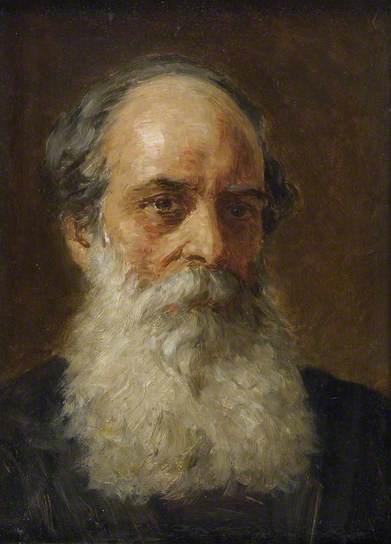 Here I must provide a proper introduction to Mr John Turtle Wood (1821-1890), (picture right) who was the the author of this map, as he plays a key role in proceedings(2). He was born in Hackney on 13th February 1821 the only child of John Wood and his wife Elizabeth. In case you are interested “Turtle” was his mother’s maiden name. He was educated privately and studied Architecture in Cambridge and Venice before designing Oatlands Park for a Mr JT Drake. Here I must provide a proper introduction to Mr John Turtle Wood (1821-1890), (picture right) who was the the author of this map, as he plays a key role in proceedings(2). He was born in Hackney on 13th February 1821 the only child of John Wood and his wife Elizabeth. In case you are interested “Turtle” was his mother’s maiden name. He was educated privately and studied Architecture in Cambridge and Venice before designing Oatlands Park for a Mr JT Drake.
Our interest however stems from the fact that in 1858 he accepted an appointment as architect to the Smyrna and Aidin Railway in Western Turkey, designing the stations on that line. His great ambition however was to discover the remains of the famous Temple of Artemis (or Diana) at Ephesus which had completely disappeared from sight in the middle ages. Accordingly he resigned his appointment and began his search. His own account of his research is contained in his book " Discoveries at Ephesus" which was published in 1877 from which the above picture of the ruins appears on pages 193/4..
The British Museum agreed to get him a permit and to give him a grant, in return for any antiquities he might discover. By August 1862 the Railway was regularly running passengers on tour in Europe to see the ruins. Wood met with many obstacles. The region was infested with bandits. Workers were hard to find. His budget was too small. During his first season he was thrown from a horse, breaking his collar bone. Perhaps the biggest difficulty however was that he had no idea where the temple was located in the massive site of ruins.
In 1863 he started sinking test pits and was therefore already present in Turkey in charge of extensive excavations by the time the Christopher family arrived late in 1864. Many of the men working on the railway were of course experienced excavators and employed digging out the cuttings and tunnels for the railway to run through Ephesus Pass and with the huge interest shown in the site during these years it's not surprising to find that many unofficially lent a hand. Henry himself was actually employed by the OCR as a carriage Inspector, and his son as an engine driver, so they would have met John Turtle Wood many times as he traveled backwards and forwards down the line which he did on a regular basis. All the supplies and equipment for his site at Ephesus were conveyed on the railway and artifacts discovered there regularly brought back to Smyrna. Some of these made their way to the British Museum and can still be viewed there today. Many of the rich and famous came to visit the ruins and In April 1865 just before the Cholera outbreak HRH Prince Arthur arrived traveling down the railway from Smyrna. John Wood's account of his discoveries at Ephesus has the following dedication "With the gracious permission of her Majesty the Queen This Book is dedicated with the greatest respect to His Royal Highness Prince Arthur Duke of Connaught and Stratearne, (etc) In remembrance of the visit of his Royal Highness to Ephesus and of a few bright days during which the author had the honour and pleasure of accompanying his Royal Highness to Mitylene, Pergamos and Assos in the year 18654"
Sadly only 4 months later Henry and Mary lost both their own son Joseph Henry CHRISTOPHER and Henry's father to the cholera outbreak that year which swept through the region in August 1865. That year also saw John Wood stabbed within an inch of his heart during an assassination attempt made upon the British Consul in Smyrna. On 30th December 1865 the British Chaplin, a Mr William B Lewis, made a formal notification of the Deaths to the Registrar. Perhaps it was John Wood himself that advised the Consul of their demise. After the outbreak of Cholera had abated work on completing the cutting through Ephesus Pass recommenced. Henry Christopher Junior was to complete his contract with the Railway Company and as far as I know continued to assist John Wood with his excavations.
6. Discovery of the 'Temple of Artemis' at Ephesus
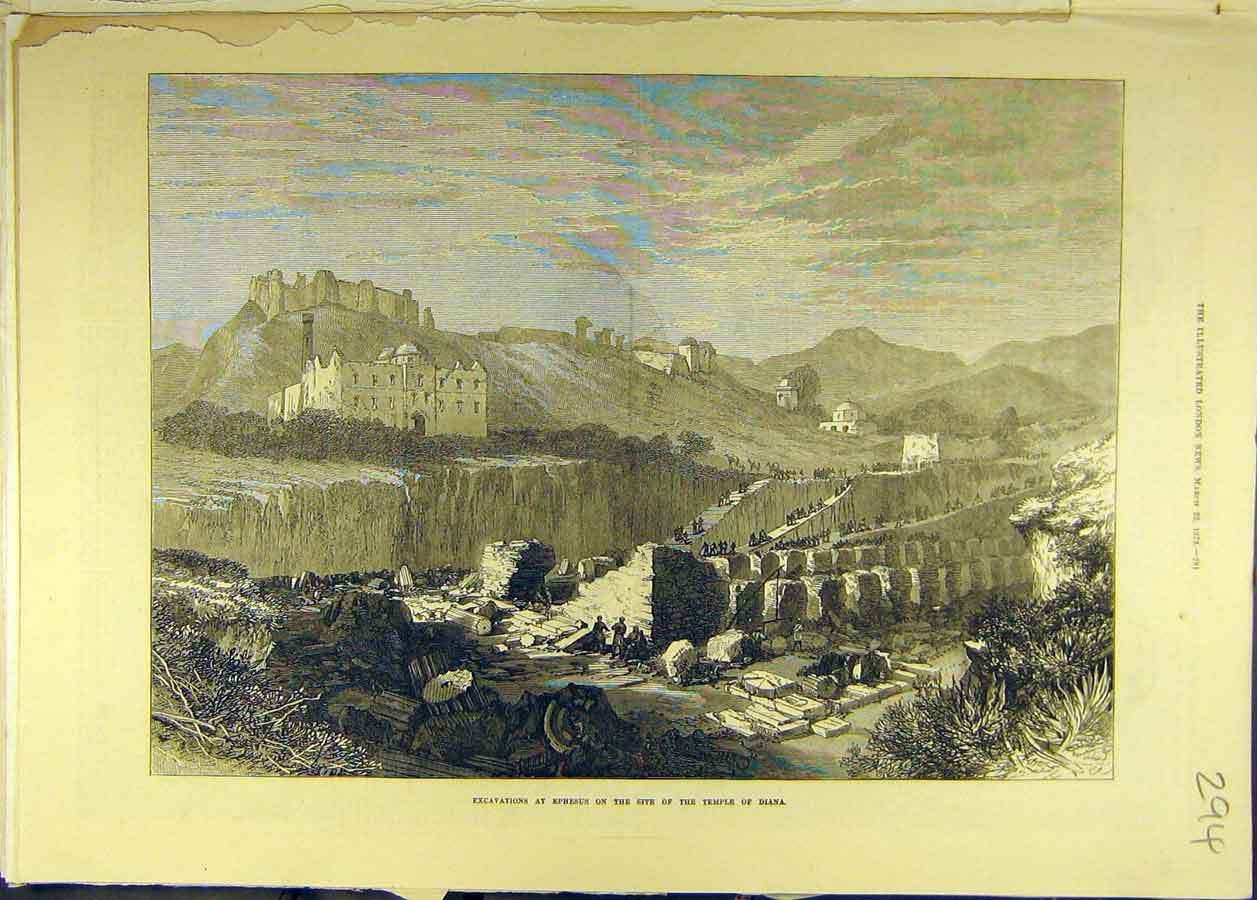
The Temple of Artemis
One of the Seven Wonders of the Ancient world
The first Temple of Artemis [later called Diana by the Romans] was built in 550 BC, and was described as one of the seven wonders of the ancient world. It was made entirely of marble, and was the largest building in the Greek world. According to Pliny, it was 115 meters by 55 meters in size, and some of its 127 columns were up to 17.65 meters high. The original temple was destroyed about 350 BC, and was rebuilt at the same size during the third century BC and an offer to pay for all expenditure by Alexander the Great was refused. It is this second temple that stood at Ephesus when as described in the Bible Paul visited the City on his travels.
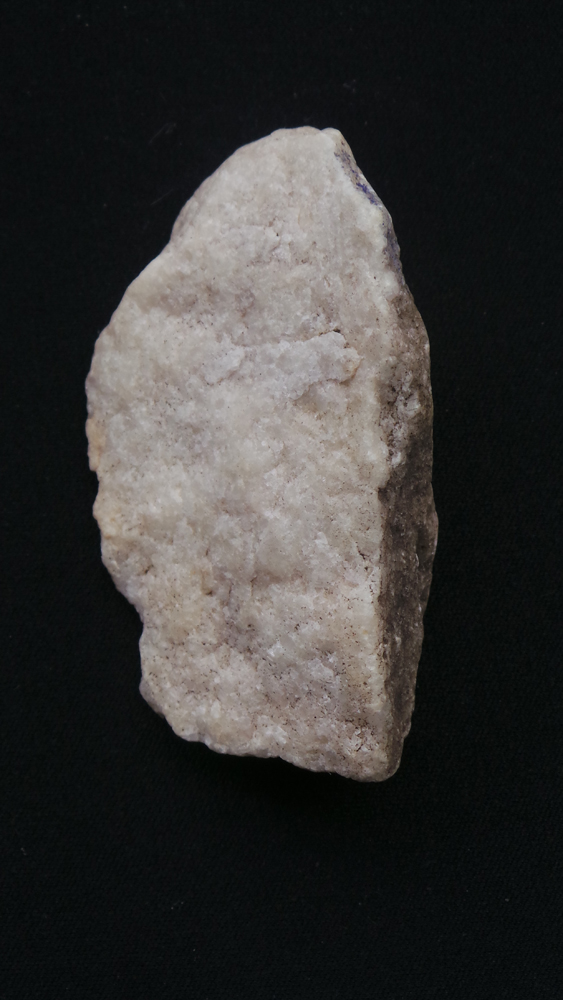
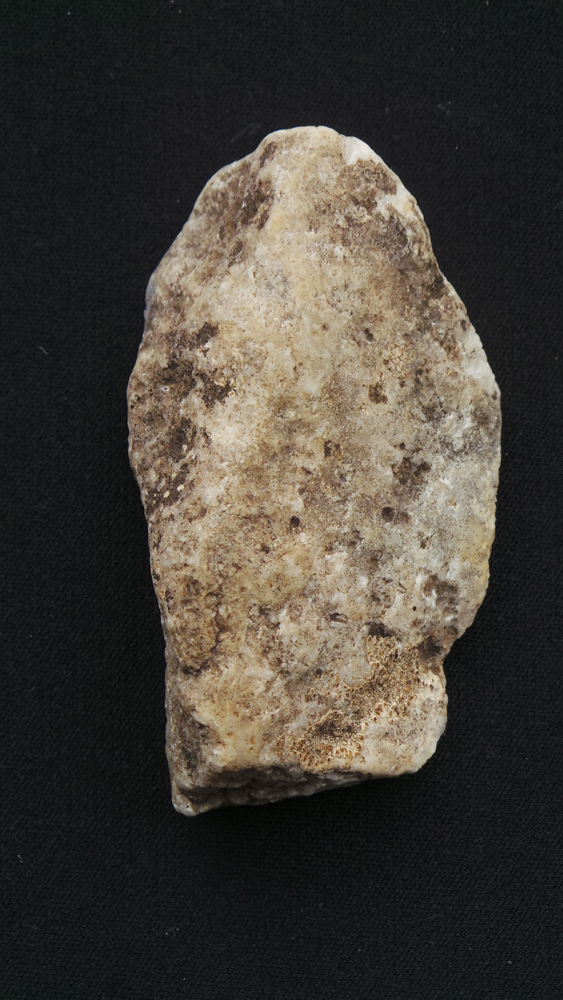 7. Marble Chipping - Ephesus 1865
7. Marble Chipping - Ephesus 1865
Another rather intriguing story related to me by my great aunt from her hospital bed was that Henry Christopher Junior is supposed to have chipped a small piece of marble off the 'Temple of Diana' as a souvenir before leaving Ephesus. When she died in 1972 my aunt left everything to my mother and sure enough among her few personal possessions wrapped in tissue paper was the marble chipping of which I have taken a front and back image.
For such an anonymous looking piece of stone it had clearly been treated by each generation with great reverence and taken a long journey to reach me. -
Henry Christopher Junior (1838-1914) took the chipping in 1865/6 at Ephesus, on his death in 1914 it passed to his son :-
Arthur William Christopher (1859-1916). On Arthur's death in 1916 it passed to his widow:-
Catherine Lucy Christopher (1857-1935) and on her death in 1935 to her youngest spinster daughter:-
Minnie Amelia Christopher (1894-1972) who was my great aunt. On her death she left everything to my mother:-
Edna Clara RUSSELL (1915-1995) nee Mc Nally (the daughter of Minnie's elder sister Emily Bertha Christopher) who in 1974 passed it to me.
As I write this in 2014 it has been in the family for 150 years. The chipping itself Is clearly of high quality white marble, and this matches many of the descriptions given by John Turtle Woods in his excavation notes regarding artifacts that he found at the site. It's also clear that the Christopher's would have known John Turtle Woods and were in close proximity to the site with an easy mode of transport to and from the excavations. I have no difficulty in believing that it came from the site and probably from one of the more prominent buildings such as the library, but it is unlikely to have come from the Temple itself:-
The Tunnel in Ephesus Pass and the rest of the line to Aidin was finished and officially opened on 1st July 1866. It seems unlikely that Henry and his family were still in Turkey for the official opening however as they had returned to live in Malden Essex by the birth of their son Ephesus Harry Christopher on 20th July 1866.
Although still obsessed about finding the Temple it was not until the following year that John Turtle Woods made a significant discovery as to its location. Whilst excavating in the ancient theatre at Ephesus, he found an inscription in Greek referring to some gold and silver statuettes, which on festive days were carried from the temple to the theatre by way of the Magnesium Gate. If he could find this gate, he reckoned that there would be a paved road leading to the temple. Late in 1867 he found the gate and the road which being deep underground was quite well preserved with marble paving 12 yards (11 meters) wide. Following its course on 2nd May 1869 he found the precinct wall of the temple enclosure.
He now bought the site on behalf of the British Museum and set out to find the temple. He found it on the last day of 1869 under nearly twenty feet of sand. Excavation was far from easy as the ground was waterlogged necessitating constant pumping and this made progress very slow. Wood then excavated the whole foundation removing 132,000 cubic yards of the swamp to leave a hole some 300 feet wide and 500 feet long. This is what is depicted in the picture above. The remains of some of the sculptured portions of the columns found were shipped to the British Museum
8. Maldon Essex 1866-1877
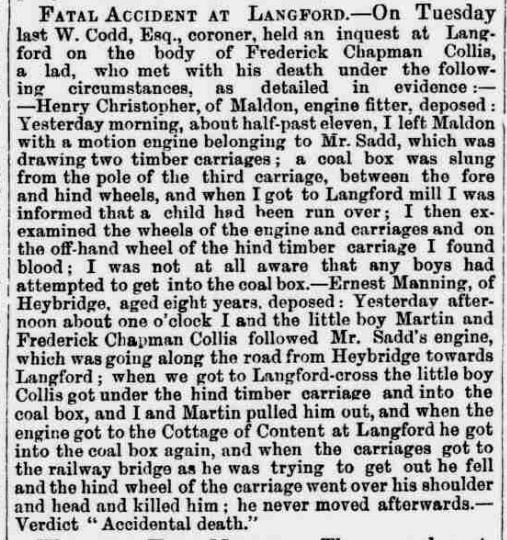 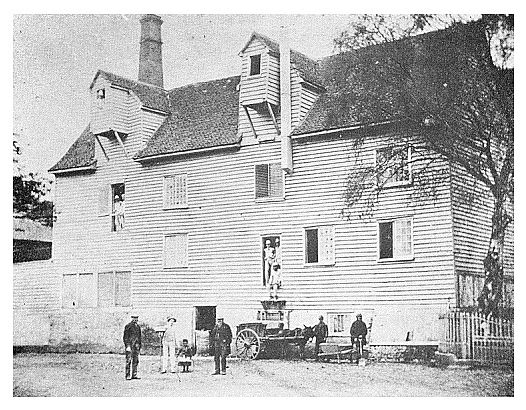 With the completion of the Railway line to Aidin the Christopher Family returned to England and headed back to Essex probably staying initially with Mary's parents at Woodham Ferrers. Henry needed a job and he appears to have been employed by John SADD and Sons who were based in nearby Maldon. The 1867 (and subsequent editions) of the Post Office Directory states that they were " English and Foreign timber & slate merchants, ship owners, wharfingers and steam saw mills owners adjoining the Great Eastern Railway" . The earliest evidence I have of Henry's return is the birth certificate for Ephesus Harry Christopher (1866-1944) which shows them living in St Peters Parish in Maldon on 12th July 1866 when Henry's occupation is shown to be that of an 'Engine Fitter'. The later Census shows them actually living in Mill Lane and Henry remains there throughout described as an 'engine fitter' until about 1877 when they moved to live at West Ham.
With the completion of the Railway line to Aidin the Christopher Family returned to England and headed back to Essex probably staying initially with Mary's parents at Woodham Ferrers. Henry needed a job and he appears to have been employed by John SADD and Sons who were based in nearby Maldon. The 1867 (and subsequent editions) of the Post Office Directory states that they were " English and Foreign timber & slate merchants, ship owners, wharfingers and steam saw mills owners adjoining the Great Eastern Railway" . The earliest evidence I have of Henry's return is the birth certificate for Ephesus Harry Christopher (1866-1944) which shows them living in St Peters Parish in Maldon on 12th July 1866 when Henry's occupation is shown to be that of an 'Engine Fitter'. The later Census shows them actually living in Mill Lane and Henry remains there throughout described as an 'engine fitter' until about 1877 when they moved to live at West Ham.
Three years after they returned, on 11th May 1869, Henry was involved in a fatal accident when a 'motion engine' that he was driving owned by the appropriately named Mr Sadd ran over and killed a small 5 year old boy called Frederick Chapman Collis. The account left is from the Chelmsford Chronicle of 14th May 1869.
As sad as this event is it opens a small window on Henry Christopher's life at this time. First he says he left Maldon about half past eleven. As the Railway line runs about 8 miles north west of Maldon he appears to have been coming instead from the wharf where he probably loaded timber destined for the Langford mill from one of their barges. Henry lived in Mill Lane which directly joins the Fullbridge road in Maldon, close to the junction with Station Road, which ran down to the extensive wharf privately owned by John Sadd and Sons. As such he was living within a short walking distance of the wharf where they would have kept and maintained the traction engines.(3)
Having loaded the timber he would then have headed out of Maldon. The boys were living in Heybridge which even then was a a large village on the north side of the river Blackwater, but really only a northern suburb of Maldon. It is a very short walk to Fulbridge road. From there it's under a mile and a half to Langford Mill. In 1869 when the accident happened the Mill was very different from the brick built structure which survives today and I have located this picture which shows it was 5 storey's high and mainly constructed of timber (the brick walls only extended to a height of 6 feet). It was owned then by Piggot & Sons a miller and the account of it's destruction refers to it working 10 stones for grinding corn. Unfortunately it's timber construction brought about it's eventual demise as it caught fire and was entirely destroyed on the night of 25th March 1879(4) .
I wanted to get a feel for the 'motion engine' and 'carriages' referred to and although the picture below shows an engine made circa 1915 it was owned by John Sadd & Sons and was reputedly used to haul timber from the forest surrounding Thetford, Suffolk to Maldon for sale within the business. The engine Henry Christopher drove would have been a much early version possibly more like the one shown in the link provided which was being made in 1869, but it was pulling timber carriages so would have been similar and the fact that John SADD & Sons was still using them post 1915 suggests that this is the way they had traditionally been hauling timber.
Garrett Tractor owned by John Sadd & Sons of Maldon c1915
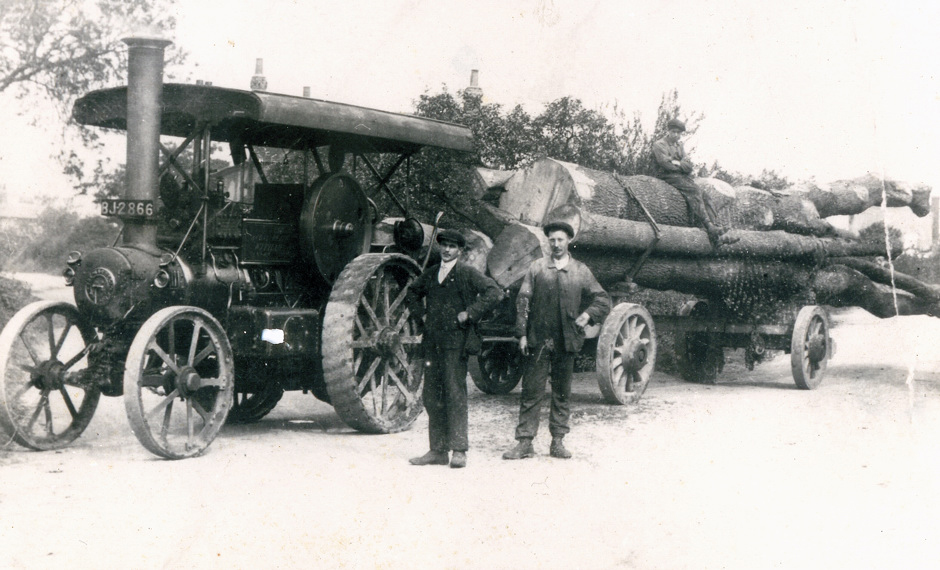
© Picture David Collidge
9. West Ham Essex 1878- 1888
By the birth of their 10th and last child Alice Sarah CHRISTOPHER (1878-1960) on 8th July 1878 they were living in Stratford West Ham but had moved by April 1881 to number 9 Kent Road in the parish of St Andrews in Plaistow. Henry has a job as a railway engine driver again, probably working out of the depot at Stratford as 1877 was the year that they opened The Jubilee Shed for the maintenance of railway engines. It was a straight through shed (engines could enter and leave from either end) with a capacity to take 130 engines it was a huge undertaking and probably created the need for more engine drivers.
10. Woodham Ferrers Essex 1889-1899
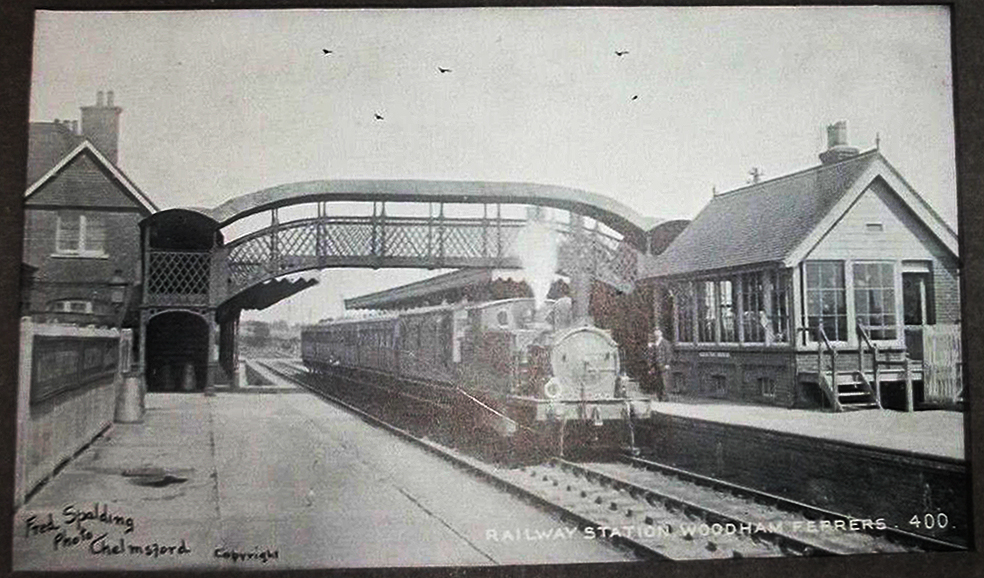 In 1889 however the London and Eastern Railway built a new Railway Station at the junction of the Southminster and Maldon branch lines which was just a mile away from the small rural village of Woodham Ferrers from which the station was to take it's name.
They also built six railway cottages. These buildings together established the first nucleus of what was eventually to become South Woodham Ferrers, but at that time was essentially a greenfield site in a thinly populated agricultural area. From the 1891 census taken in April that year we can see that the station master was the 38 year old Zephaniah Farrow a native of Suffolk who occupied one of the six cottages with his wife Sarah and two children. Henry Christopher was also working there as a signal fitter and would have been responsible for operating and maintaining the signals at the junction. He also lived in one of the cottages with his wife Mary and two youngest daughters but shared it with a carpenter George Bangs and a housekeeper. A third cottage is accounted for by William Norfolk the railway porter with his wife Catherine and 3 children and the 4th by Frederick Huges was the plate layer employed to maintain the railway track with his wife Jane and 5 children. The other cottages appear to have been rented out one to a carpenter James Saunders and his wife and 3 children and the other to a John Ayden a sub inspector who was also married with 3 children. Although their other children had flown the nest all three of the girls returned to marry in St Mary the Virgin's church at Woodham Ferrers. Eliza Ellen in 1893, and Minnie Elizabeth and Mary Ann in 1899.
In 1889 however the London and Eastern Railway built a new Railway Station at the junction of the Southminster and Maldon branch lines which was just a mile away from the small rural village of Woodham Ferrers from which the station was to take it's name.
They also built six railway cottages. These buildings together established the first nucleus of what was eventually to become South Woodham Ferrers, but at that time was essentially a greenfield site in a thinly populated agricultural area. From the 1891 census taken in April that year we can see that the station master was the 38 year old Zephaniah Farrow a native of Suffolk who occupied one of the six cottages with his wife Sarah and two children. Henry Christopher was also working there as a signal fitter and would have been responsible for operating and maintaining the signals at the junction. He also lived in one of the cottages with his wife Mary and two youngest daughters but shared it with a carpenter George Bangs and a housekeeper. A third cottage is accounted for by William Norfolk the railway porter with his wife Catherine and 3 children and the 4th by Frederick Huges was the plate layer employed to maintain the railway track with his wife Jane and 5 children. The other cottages appear to have been rented out one to a carpenter James Saunders and his wife and 3 children and the other to a John Ayden a sub inspector who was also married with 3 children. Although their other children had flown the nest all three of the girls returned to marry in St Mary the Virgin's church at Woodham Ferrers. Eliza Ellen in 1893, and Minnie Elizabeth and Mary Ann in 1899.
11. West Ham Essex 1900-1914
By 1901 they had returned to live in West Ham this time at 33 William Street which backed onto the Stratford Railway Depot. Henry was aged 63 and still working as a signal fitter so would have been in charge of some of the signals in this massive yard. In the same house with him is his wife Mary Ann (aged 65) his son Frederick Charles (33), still a bachelor working as a blacksmith, his spinster daughter Alice Sarah (22) and his married daughter Mary Ann (25) with his son-in-law David Youngs (30) a railway guard and his granddaughter Alice Rosalind Youngs aged only 8 months.
By the following census taken on 2nd April 1911 Henry is living at 85 Arthingworth Street still in West Ham. It is situated today between Stratford High Street and Abbey Road Railway stations running paralell to Bridge Road which follows the railway line. With him are his wife and 3 unmarried children Ephesus Harry, Frederick Charles and Alice Sarah. His wife Mary Ann Christopher died there aged 78 from acute bronchitis on 26th April 1914 and was soon followed by Henry Christopher Junior from a cerebral haemorrhage on the 9th August 1914 at the age of 76. Their son Ephesus Harry Christopher was present at both deaths.
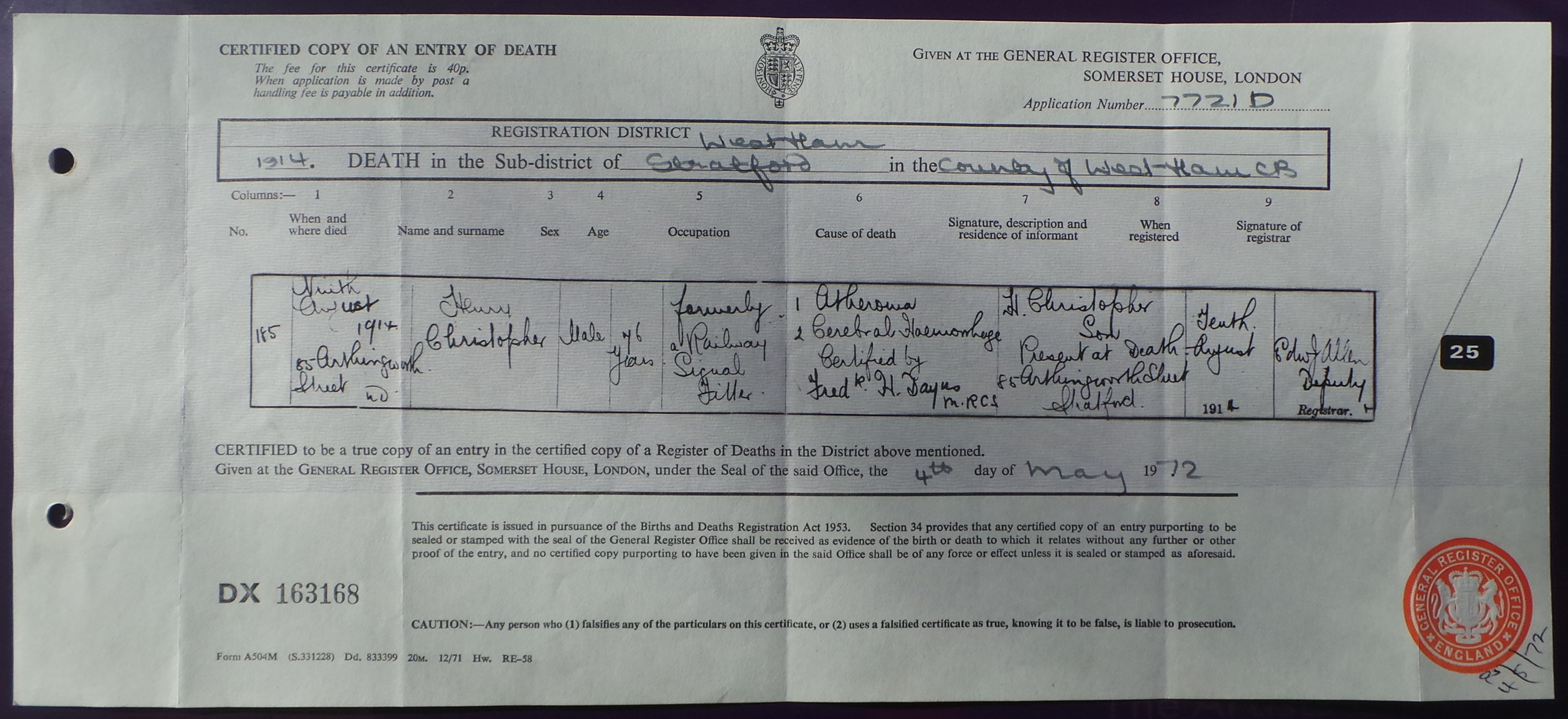
Their 10 Children (1859-1878)
(1). Arthur William CHRISTOPHER (1859-1916)
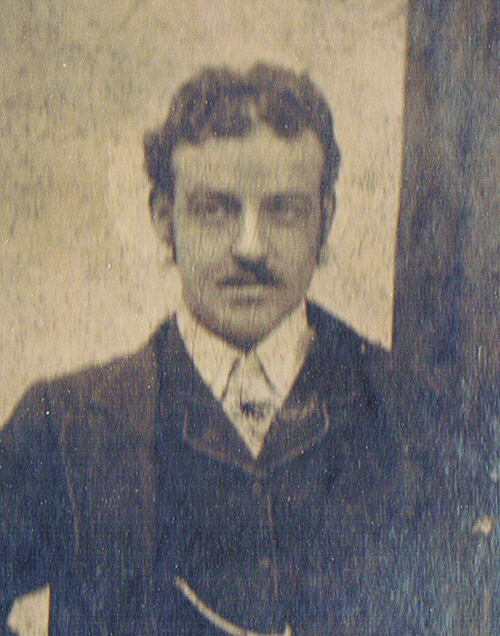 Arthur is the subject of a separate account follow link:- Arthur William Christopher (1859-1916)
Arthur is the subject of a separate account follow link:- Arthur William Christopher (1859-1916)
Briefly born on 29th January 1859 at Alfred Terrace in Stratford the family moved to Sydenham in Kent where his father was an engine driver on the railways. He was baptised on 31st May 1863 at St Bartholomew's church with his younger sister Eliza Ellen. At the age of 5 he traveled with his parents to Turkey arriving at Smyrna in Dec 1864 and lived for a time in Ephesus Pass where he survived an outbreak of Cholera that killed his grandfather and younger brother in 1865. He returned with his parents to live in Mill Lane in Maldon in Essex by 1866 and remained there until about 1877 when they moved again to live in Stratford. by 1881 they were living at 116 Henniker road in West Ham.
Here the family was reacquainted with the Denman family who were living at 8 Heyworth Terrace in Stratford, and he married at the age of 22 to Catherine Lucy DENMAN at the local United Free Methodist church on the 10th September 1881. They had 8 children one of which was my grandmother. Arthur died at the age of 57 on 23rd Sep 1916 and was buried at the Wickford Congregational Cemetery in Essex.
(2). Eliza Ellen CHRISTOPHER (1862-1863) Born at Edney Street just off Wells Road in Sydenham in Kent on 23rd Dec 1862 she was baptised at nearby st Bartholomew's church on 31st May 1863 with her younger brother. She died according to her death certificate from convulsions whilst teething at the Key's family home in Woodham Ferris Essex on 17th Aug 1863 being buried on the 23rd.
(3). Joseph Henry CHRISTOPHER (1864-1865) Born at 16 Fir Street again just off Wells Road on Sydenham in Kent on 7th Oct 1884 he was baptised at St Bartholomew's with his elder sister. He traveled to Turkey with his parents in Dec 1864 and died at Ephesus Pass from an outbreak of Cholera on 10th August 1865 he was buried either by the railway track in the pass or at the cemetery at Ayasalouk.
(4). 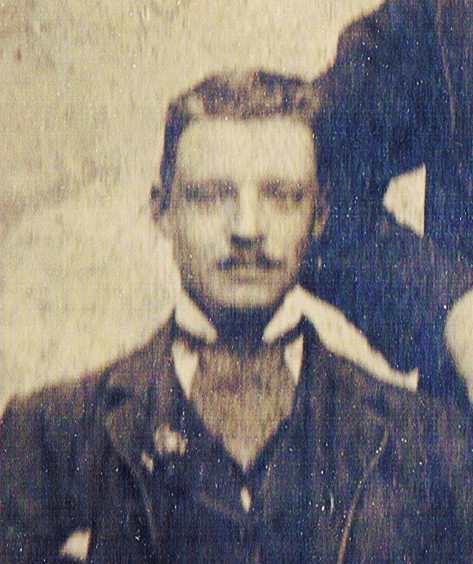 Ephesus Henry CHRISTOPHER (1866-1944) Ephesus Henry CHRISTOPHER (1866-1944)
Conceived on Mount Coressus in Turkey he was born on 20th July 1866 back in England at Maldon in Essex and baptised at St Peters Church in the village by the Rev E.R.King on 26th of the following month. Moved to West Ham with the family as a young man before enlisting at Ipswich on 13th Oct 1883 as Harry Christopher in the 3rd Brigade of the Royal Artillery [Service Number 39395] when he was described as being 5 feet 8 inches tall with grey eyes and brown hair. Served at Woolwich Arsenal 1885 and transferred to 1st Brigade 23rd Nov 1887. Posted to India with Regt embarked on HMS Malabar an iron screw troopship on 30th Sep 1890, arriving at India on 24th Oct 1890. At Faizabad Uttar Pradesh 18th Nov 1890; Meean Meer Lahore 1894; Deolali Maharashtra 23rd Feb 1895 before returning to England on board SS Britania on 6th Mar 1895 arriving at Chatham 12th April 1895.
He also served in South Africa and was wounded at Mafeking on 15th Nov 1900 when he was attached to part of an ammunition column . He was also at Potchefstroom Transvaal South Africa 14th Oct 1902 after which he was discharged at own request after 18 years service? Awarded the 1901 and the 1902 South Africa Kings Medal with clasps for Cape Colony and Transvaal. Returned to live with parents at 85 Arthingworth Street West Ham. Became a construction worker erecting the iron infrastructure of buildings and present at the death of both his mother and father in 1914. Tried to re-enlist in the Army in 1915 but declared medically unfit. Died of cancer of the thoat on 19th July 1944 at Mount Vernon Hospital Northwood in Middlesex whilst living at 62 West Ham Lane Uxbridge, leaving a modest estate of just £92.10s 6d to his sister Alice. He was buried at West Ham cemetery Family Grave 113559 PA
(5). Frederick Charles CHRISTOPHER (1868-1933) Born on 20th May 1868 he was baptised at St Peters Church in Maldon on 30th August 1868. He moved with his parents from Maldon in Essex to live at West Ham.I have not been able to locate him in 1891 census but he was a blacksmith by trade and living with his parents in 1901 at 33 William Street in West Ham. By 1911 they have moved locally living at 85 Arthingworth Street where he is recorded as a blacksmith working for the Great Eastern Railway probably at the Stratford Railway Depot near by. He died there a bachelor at the age of 64 when he left a modest £114. 18s 4d to his siter Alice.
(6). Peter CHRISTOPHER (1870-1903) Born on 4th March 1870 he was baptised at St Peters Church in Maldon on 27th Oct 1872 with his sister Eliza. Like his siblings he moved from Maldon in Essex to West Ham with his parents before marriage to Adelaide Hazel on 26th Mar 1891. Adelaide was the 4th child by her father John Hazell (1814-1876) by his second wife Caroline Ablewhite nee Booth (1825-1893). They lived after marrriage at 11 Hill Street in Ipswich where Adelaide gave birth to 2 children (shown below). Peter appears to have moved to number 23 Hill Street as he was reported in the Ipswich Journal on Satrurday 14th Nov 1896 as saving 2 children at number 16 when their house caught fire. Adeliade died on 22nd May 1898 according to my mother from complications associated with the birth nof her next child but we would need the death certificate to confirm that. Peter is said to have remarried to Mary Ann Winn nee Dunnett around 1900 but I have not been able to locate a marriage. Peter is however shown living with her in the 1901 census at 190 Rose Hill in Ipswich. peter died in Feb 1903 still only 32 years old. Mary re-married to Damiel Edward Snell in Oct 1904.
(6.1) Frederick Charles CHRISTOPHER (1891-1972)
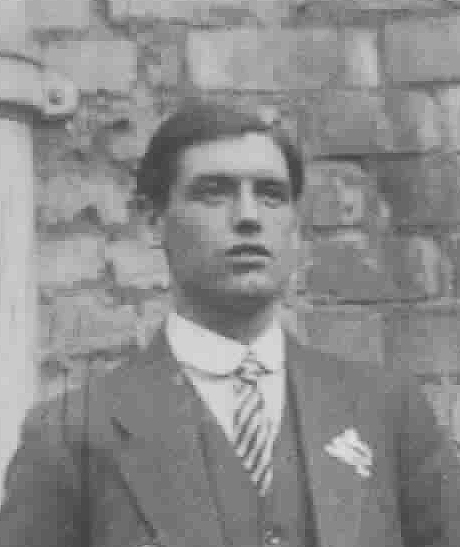 On 12th Nov 1906 he went to work for Carter Patterson & Co Ltd. A Carrier company 'Carter Paterson' was founded in 1860 by Walter Carter, John Paterson James Paterson, and Robert Paterson. It adopted the name Carter Paterson & Co on January 1, 1869 and in 1887, it became a limited company. Its head office was located at 128 Goswell Road, EC1. Like other leading carriers, Carter Paterson & Co worked closely with the railways. In the late 19th century it was the country's largest carrier, with more than 2,000 horses in its 20 London depots. One such depot was in Mandrell Road in Brixton. The company acquired the premises, which included stables and several buildings, in 1901. These were largely rebuilt and enlarged in 1904 to meet growing demand for the company's services in the area.
On 12th Nov 1906 he went to work for Carter Patterson & Co Ltd. A Carrier company 'Carter Paterson' was founded in 1860 by Walter Carter, John Paterson James Paterson, and Robert Paterson. It adopted the name Carter Paterson & Co on January 1, 1869 and in 1887, it became a limited company. Its head office was located at 128 Goswell Road, EC1. Like other leading carriers, Carter Paterson & Co worked closely with the railways. In the late 19th century it was the country's largest carrier, with more than 2,000 horses in its 20 London depots. One such depot was in Mandrell Road in Brixton. The company acquired the premises, which included stables and several buildings, in 1901. These were largely rebuilt and enlarged in 1904 to meet growing demand for the company's services in the area.
Frederick attested for the Army in 1910 (Soldier 9406) making Lance Corporal in 1912 serving in the 2nd West Yorkshire Regiment, before being posted to Malta on 13th Mar 1913 where he served until returning in Sep 1914 at the outbreat of WW1. He joined the British Expeditionary Force in France on 5th Nov 1914 but was wounded in the left leg by shrapnel and was sent home 17th Mar 1915. He was awarded the Silver war badge, 1914 bronze star, and the British War and Victory Medals being discharged as physically unfit for war service 17th Dec 1915. He lived at 75 Arthgingworth St in West Ham E15. Here he met Margaret Ethel Annie WORTLEY whom he married on 4th Oct 1919. Frederick died at the age of 81 abt Aug 1972
in Hackney London. I met his widow Margaret in the mid 1970's when she gave me some of the birth and marriage dates for her children but she was already bedridden.
(6.2) Gweneth Hayzel CHRISTOPHER (1931- )
Born abt May 1931 she married twice initially to Alexander M DOW in 1950 and later to Frank F Wyatt in 1956. They lived with her parents in the 1960's at 2 Rom Crescent Hornchurch in Essex.
(7). Eliza Ellen CHRISTOPHER (1872-1942)
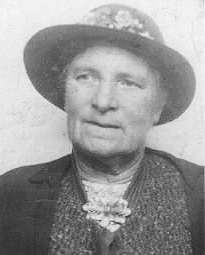 Born on 10th May 1872 at Maldon in Essex she was baptised in the village with her elder brother at St Peters Church on 27th Oct 1872. She also moved with the family to live in West Ham and at the age of 19 was working in St Marylebone as a sevant with her younger sister Minnie Elizabeth. She married John WEST a seaman at St Mary the Virgin Church in Woodham Ferrers in Essex on 22nd July 1893 . Born on 10th May 1872 at Maldon in Essex she was baptised in the village with her elder brother at St Peters Church on 27th Oct 1872. She also moved with the family to live in West Ham and at the age of 19 was working in St Marylebone as a sevant with her younger sister Minnie Elizabeth. She married John WEST a seaman at St Mary the Virgin Church in Woodham Ferrers in Essex on 22nd July 1893 .
After marriage they lived at 110 Clarence Road in Canning Town West Ham where they raised a family before moving to Plaistow around 1902. Eliza Ellen had 8 children and was pregnant with her ninth and last child when they decided to emigrate to New Zealand.
They departed Gravesend on 8th May 1913 on the SS Rumuera and a daughter was born on board ship whom they named Charlotte Remuera West. After arrival they settled initially at 8 Gordon Street in Wellington but John West went wehere he could find work and in 1919 he was working as a Mill hand in the Bay of Plenty living at Waimarino. They are later that year recorded at Rangitkei, Manawatu-Wanganui but be 1928 were at West Lynwood Road, New Lynn on the Auckland suburbs. Eliza died at the age of 70 on 23rd May 1942 and was buried at Waiakamete Cemetery. John West died on 16th March 1959 at Manurewa Auckland.
(8). Minnie Elizabeth CHRISTOPHER (1873-1962) Born on 10th Nov 1873 at Maldon in Essex she stayed with the family during her youth working during her teenage years in Marylebone with her sister Eliza for a farmer of 270 acres called Samuel John Dennis. Minnie Elizabeth returned to Essex working as a barmaid and on 2nd April 1899 married a coppersmith by the name of Robert [Ousby] HOWELL at Woodham Ferrers.
Robert had been born on 21st Nov 1865 as Robert Ousby Lancaster (5) the son of Thomas Lancaster (1828-1887) and Ann Orr Ousby (1828-1906). By the age of 15 he was working as a stable boy for the Rev. William S Salmon at Brougham Rectory in Westmoreland. He next appears in the 1885 Westmoreland Street Directory as a cattle dealer resident at 105 Belle Vue Place Highgate. Something then happened to cause him to change direction as he left for London and changed his surname to Howell appearing in the April 1891 census working as a labourer in an iron foundry and living at 17 Armstrong place in Plumstead.
Eight years later he married Minnie Elizabeth Christopher.
They initially moved to live at 48 Malmesbury Road Canning Town in West Ham where they had a son Robert Albert Christopher Howell in 1902. They moved again to Newcastle when the Thames Ironworks (the shipbuilding industry as it was then) went up North and had another son George Henry Howell in 1910. Her husband died on 6th Oct 1946 when his name is given as Robert Ousby Howell and their address as 12 Stoneylea Lemington Northumberland. His death is recorded as Robert O Howell and administration of his estate of £708. 16s. 9d was granted to Minnie Elizabeth Howell his widow on 26th Nov 1946. I have not been able to locate a birth however showing this second name, nor was it used on his marriage or census. Minnie died at 29 Valley Road West Bridgford Nottinghamshire on 15th Nov 1962 leaving £3,343.1s to her son Henry George Howell a research director.
(9). Mary Ann CHRISTOPHER (1875-1968) Born on 8th Dec 1875 at Maldon in Essex she moved with her parents to West Ham and by 1891 was living in the Railway Cottages at Woodham Ferrers in Essex by which time she was 15. Mary Ann married there in St Mary's church on 7th Oct 1899 to a David Youngs who was a guard on the Railway at Stratford. Here siblings Frederick and Alice were witnesses. They were living in April 1901 at 33 William street West Ham and I am led to believe that the marriage as such was not looked upon favourably by Henry who is also supposed to have put an end to Alice's designs at one time. At any rate Mary and her husband moved with his work to Epping where she spent the rest of her life raising a medium sized family. All the people that I have spoken to who knew her, say with one accord, that she was a very likeable person who, as one individual put it, "had not an unkind action in her body".
(10) Alice Sarah CHRISTOPHER (1878-1960)
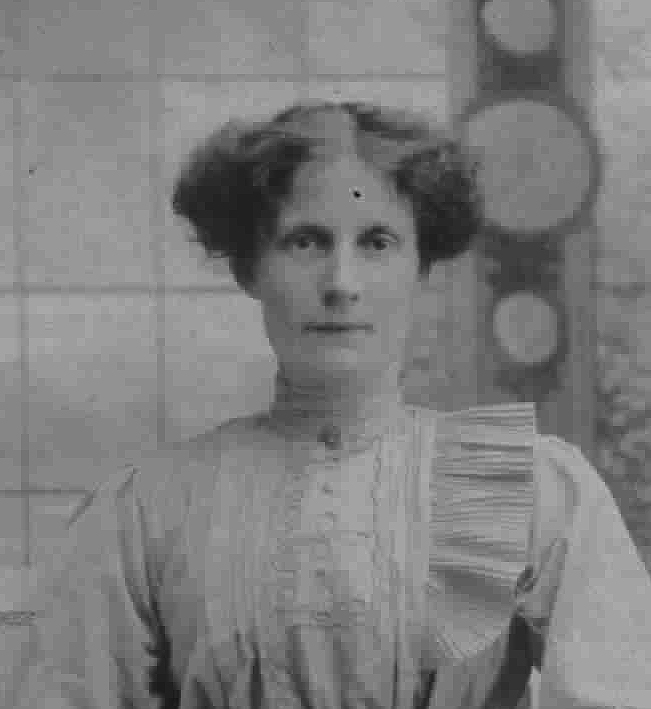 Alice was born at 44 Mortham Street, Stratford West Ham in Essex on the 8th July 1878 and lived with her parents moving in 1889 with them to Woodham Ferrers where they remained for a decade. At the age of 21 she was a witness with her brother Frederick Charles Christopher at St Mary the Virgin's church in Woodham Ferrers at the wedding of her elder sister Mary Ann Christopher to David Youngs on 7th Oct 1899. She returned with her parents to Stratford in 1900 living with them at 33 Williams Street next to the Stratford Railway Depot. They moved again to live at 85 Arthingworth Street in West Ham where both her parents died in 1914 leaving her and her 2 unmarried brothers in possession of the house although this was no doubt rented. No occupation is given for her in either the 1901 or the 1911 census returns suggesting that she very much took on the role of housekeeper particularly as her parents aged and after they died for her two elder brothers with whom she continued to live. Like so many of the youngest girls belonging to large families in those days she never married and inherited the modest estates of Frederick (£114) when he died in 1933 and Ephesus (£92) in 1944. Alice was born at 44 Mortham Street, Stratford West Ham in Essex on the 8th July 1878 and lived with her parents moving in 1889 with them to Woodham Ferrers where they remained for a decade. At the age of 21 she was a witness with her brother Frederick Charles Christopher at St Mary the Virgin's church in Woodham Ferrers at the wedding of her elder sister Mary Ann Christopher to David Youngs on 7th Oct 1899. She returned with her parents to Stratford in 1900 living with them at 33 Williams Street next to the Stratford Railway Depot. They moved again to live at 85 Arthingworth Street in West Ham where both her parents died in 1914 leaving her and her 2 unmarried brothers in possession of the house although this was no doubt rented. No occupation is given for her in either the 1901 or the 1911 census returns suggesting that she very much took on the role of housekeeper particularly as her parents aged and after they died for her two elder brothers with whom she continued to live. Like so many of the youngest girls belonging to large families in those days she never married and inherited the modest estates of Frederick (£114) when he died in 1933 and Ephesus (£92) in 1944.
Alice died at the age of 82in 1960 and as far as I can tell did not leave a will. Nor have I been able to locate a Letter of Administration for her estate which is strange as she had no children. Of her siblings only her two sisters, Minnie Ellizabeth Howell who was 87 and living in Hertfordshire and Mary Ann Youngs who was 85 and living in Epping were still alive.
We are still in touch with Mary's descendants and nothing much seems to have descended to them from the time of Herny Christopher so if there were any photographs etc they would have gone to Minnie who was strictly Alice's next of kin. Minnie
herself died 2 years later and her son Robert in 1987.
Genealogical Notes:-
(1). Maud's daughter Marie Christopher (1918-1992) was my 1st Cousin once removed and also interested in the history of her family and helped me with research in the mid 1970's
(2). His picture is reproduced by kind permission of the BBC for non-commercial research and private study purposes and can be found at the 'Your Paintings' website.
(3). A major redevelopment of this area (still called Sadd's Wharf) was agreed in 2013.
(4). A account of the fire appears in the Chelmsford Chronicle [British Newspapers Archives]
See the edition for Friday 28th March 1879Page 6 column one
(5) Robert Ousby Lancaster GRO 1865 4th qtr Ref 10b 361) Ousby was his mothers maiden name |
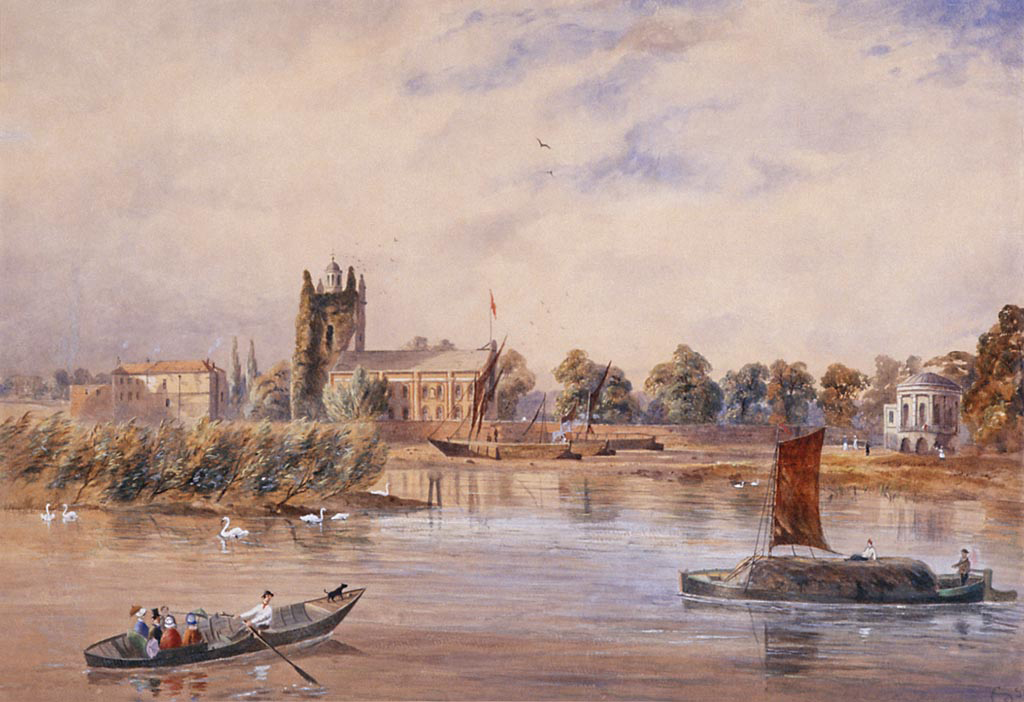

 The ceremony was carried out by the resident vicar of All Saints the Rev Henry Glossop MA (1780-1869) a graduate of Corpus Christie in Cambridge who had been vicar there since 1821. Although the painting above was done some 20 years later it was very much the scene that greeted him that day with the ferry running across the Thames from the steps in front of the church to old Deer Park. Little did he know that he was the first of their 10 children.
The ceremony was carried out by the resident vicar of All Saints the Rev Henry Glossop MA (1780-1869) a graduate of Corpus Christie in Cambridge who had been vicar there since 1821. Although the painting above was done some 20 years later it was very much the scene that greeted him that day with the ferry running across the Thames from the steps in front of the church to old Deer Park. Little did he know that he was the first of their 10 children.

 I have not been able to locate any records that directly relate to Henry CHRISTOPHER Senior during these three years but various documents recorded shortly after his death refer to him being a carpenter. We know that his son and daughter in law were living with him as Mary Ann was taking care of his younger children, and it's clear from her children's birth and baptism certificates that Henry Christopher Junior was employed on the Railways as an engine driver and that by the end of 1862 they were living at Wells Road in Sydenham Kent. Their second child Eliza Ellen CHRISTOPHER (1862-1863) was born at 'Edney Street' on 'Wells Road' on 23rd Dec 1862 . Edney Street is gone now but used to run along the north side of what is now 'Sydenham Wells Park' . The north boundary of the park is shown on modern maps running along 'Wells Park Road' which was simply called 'Wells Road' prior to the park being opened to the public in 1901.
I have not been able to locate any records that directly relate to Henry CHRISTOPHER Senior during these three years but various documents recorded shortly after his death refer to him being a carpenter. We know that his son and daughter in law were living with him as Mary Ann was taking care of his younger children, and it's clear from her children's birth and baptism certificates that Henry Christopher Junior was employed on the Railways as an engine driver and that by the end of 1862 they were living at Wells Road in Sydenham Kent. Their second child Eliza Ellen CHRISTOPHER (1862-1863) was born at 'Edney Street' on 'Wells Road' on 23rd Dec 1862 . Edney Street is gone now but used to run along the north side of what is now 'Sydenham Wells Park' . The north boundary of the park is shown on modern maps running along 'Wells Park Road' which was simply called 'Wells Road' prior to the park being opened to the public in 1901. 
 In the twilight of her life my great aunt Minnie Amelia Christopher (1894-1972) broke her hip and on the many visits to her in hospital with my mother, and later at an old people’s home in Westcliff-on-Sea, she would tell me stories about the families time in Turkey which had been related to her during her childhood by her father Arthur William Christopher. Arthur of course had actually been there, although only 7 years old when they left.
In the twilight of her life my great aunt Minnie Amelia Christopher (1894-1972) broke her hip and on the many visits to her in hospital with my mother, and later at an old people’s home in Westcliff-on-Sea, she would tell me stories about the families time in Turkey which had been related to her during her childhood by her father Arthur William Christopher. Arthur of course had actually been there, although only 7 years old when they left.  Here I must provide a proper introduction to Mr John Turtle Wood (1821-1890), (picture right) who was the the author of this map, as he plays a key role in proceedings(2). He was born in Hackney on 13th February 1821 the only child of John Wood and his wife Elizabeth. In case you are interested “Turtle” was his mother’s maiden name. He was educated privately and studied Architecture in Cambridge and Venice before designing Oatlands Park for a Mr JT Drake.
Here I must provide a proper introduction to Mr John Turtle Wood (1821-1890), (picture right) who was the the author of this map, as he plays a key role in proceedings(2). He was born in Hackney on 13th February 1821 the only child of John Wood and his wife Elizabeth. In case you are interested “Turtle” was his mother’s maiden name. He was educated privately and studied Architecture in Cambridge and Venice before designing Oatlands Park for a Mr JT Drake. 



 With the completion of the Railway line to Aidin the Christopher Family returned to England and headed back to Essex probably staying initially with Mary's parents at Woodham Ferrers. Henry needed a job and he appears to have been employed by John SADD and Sons who were based in nearby Maldon. The 1867 (and subsequent editions) of the Post Office Directory states that they were " English and Foreign timber & slate merchants, ship owners, wharfingers and steam saw mills owners adjoining the Great Eastern Railway" . The earliest evidence I have of Henry's return is the birth certificate for Ephesus Harry Christopher (1866-1944) which shows them living in St Peters Parish in Maldon on 12th July 1866 when Henry's occupation is shown to be that of an 'Engine Fitter'. The later Census shows them actually living in Mill Lane and Henry remains there throughout described as an 'engine fitter' until about 1877 when they moved to live at West Ham.
With the completion of the Railway line to Aidin the Christopher Family returned to England and headed back to Essex probably staying initially with Mary's parents at Woodham Ferrers. Henry needed a job and he appears to have been employed by John SADD and Sons who were based in nearby Maldon. The 1867 (and subsequent editions) of the Post Office Directory states that they were " English and Foreign timber & slate merchants, ship owners, wharfingers and steam saw mills owners adjoining the Great Eastern Railway" . The earliest evidence I have of Henry's return is the birth certificate for Ephesus Harry Christopher (1866-1944) which shows them living in St Peters Parish in Maldon on 12th July 1866 when Henry's occupation is shown to be that of an 'Engine Fitter'. The later Census shows them actually living in Mill Lane and Henry remains there throughout described as an 'engine fitter' until about 1877 when they moved to live at West Ham.
 In 1889 however the London and Eastern Railway built a new Railway Station at the junction of the Southminster and Maldon branch lines which was just a mile away from the small rural village of Woodham Ferrers from which the station was to take it's name.
They also built six railway cottages. These buildings together established the first nucleus of what was eventually to become South Woodham Ferrers, but at that time was essentially a greenfield site in a thinly populated agricultural area. From the 1891 census taken in April that year we can see that the station master was the 38 year old Zephaniah Farrow a native of Suffolk who occupied one of the six cottages with his wife Sarah and two children. Henry Christopher was also working there as a signal fitter and would have been responsible for operating and maintaining the signals at the junction. He also lived in one of the cottages with his wife Mary and two youngest daughters but shared it with a carpenter George Bangs and a housekeeper. A third cottage is accounted for by William Norfolk the railway porter with his wife Catherine and 3 children and the 4th by Frederick Huges was the plate layer employed to maintain the railway track with his wife Jane and 5 children. The other cottages appear to have been rented out one to a carpenter James Saunders and his wife and 3 children and the other to a John Ayden a sub inspector who was also married with 3 children. Although their other children had flown the nest all three of the girls returned to marry in St Mary the Virgin's church at Woodham Ferrers. Eliza Ellen in 1893, and Minnie Elizabeth and Mary Ann in 1899.
In 1889 however the London and Eastern Railway built a new Railway Station at the junction of the Southminster and Maldon branch lines which was just a mile away from the small rural village of Woodham Ferrers from which the station was to take it's name.
They also built six railway cottages. These buildings together established the first nucleus of what was eventually to become South Woodham Ferrers, but at that time was essentially a greenfield site in a thinly populated agricultural area. From the 1891 census taken in April that year we can see that the station master was the 38 year old Zephaniah Farrow a native of Suffolk who occupied one of the six cottages with his wife Sarah and two children. Henry Christopher was also working there as a signal fitter and would have been responsible for operating and maintaining the signals at the junction. He also lived in one of the cottages with his wife Mary and two youngest daughters but shared it with a carpenter George Bangs and a housekeeper. A third cottage is accounted for by William Norfolk the railway porter with his wife Catherine and 3 children and the 4th by Frederick Huges was the plate layer employed to maintain the railway track with his wife Jane and 5 children. The other cottages appear to have been rented out one to a carpenter James Saunders and his wife and 3 children and the other to a John Ayden a sub inspector who was also married with 3 children. Although their other children had flown the nest all three of the girls returned to marry in St Mary the Virgin's church at Woodham Ferrers. Eliza Ellen in 1893, and Minnie Elizabeth and Mary Ann in 1899.
 Arthur is the subject of a separate account follow link:-
Arthur is the subject of a separate account follow link:-  Ephesus Henry CHRISTOPHER (1866-1944)
Ephesus Henry CHRISTOPHER (1866-1944)  On 12th Nov 1906 he went to work for Carter Patterson & Co Ltd. A Carrier company 'Carter Paterson' was founded in 1860 by Walter Carter, John Paterson James Paterson, and Robert Paterson. It adopted the name Carter Paterson & Co on January 1, 1869 and in 1887, it became a limited company. Its head office was located at 128 Goswell Road, EC1. Like other leading carriers, Carter Paterson & Co worked closely with the railways. In the late 19th century it was the country's largest carrier, with more than 2,000 horses in its 20 London depots. One such depot was in Mandrell Road in Brixton. The company acquired the premises, which included stables and several buildings, in 1901. These were largely rebuilt and enlarged in 1904 to meet growing demand for the company's services in the area.
On 12th Nov 1906 he went to work for Carter Patterson & Co Ltd. A Carrier company 'Carter Paterson' was founded in 1860 by Walter Carter, John Paterson James Paterson, and Robert Paterson. It adopted the name Carter Paterson & Co on January 1, 1869 and in 1887, it became a limited company. Its head office was located at 128 Goswell Road, EC1. Like other leading carriers, Carter Paterson & Co worked closely with the railways. In the late 19th century it was the country's largest carrier, with more than 2,000 horses in its 20 London depots. One such depot was in Mandrell Road in Brixton. The company acquired the premises, which included stables and several buildings, in 1901. These were largely rebuilt and enlarged in 1904 to meet growing demand for the company's services in the area.  Born on 10th May 1872 at Maldon in Essex she was baptised in the village with her elder brother at St Peters Church on 27th Oct 1872. She also moved with the family to live in West Ham and at the age of 19 was working in St Marylebone as a sevant with her younger sister Minnie Elizabeth. She married John WEST a seaman at St Mary the Virgin Church in Woodham Ferrers in Essex on 22nd July 1893 .
Born on 10th May 1872 at Maldon in Essex she was baptised in the village with her elder brother at St Peters Church on 27th Oct 1872. She also moved with the family to live in West Ham and at the age of 19 was working in St Marylebone as a sevant with her younger sister Minnie Elizabeth. She married John WEST a seaman at St Mary the Virgin Church in Woodham Ferrers in Essex on 22nd July 1893 .  Alice was born at 44 Mortham Street, Stratford West Ham in Essex on the 8th July 1878 and lived with her parents moving in 1889 with them to Woodham Ferrers where they remained for a decade. At the age of 21 she was a witness with her brother Frederick Charles Christopher at St Mary the Virgin's church in Woodham Ferrers at the wedding of her elder sister Mary Ann Christopher to David Youngs on 7th Oct 1899. She returned with her parents to Stratford in 1900 living with them at 33 Williams Street next to the Stratford Railway Depot. They moved again to live at 85 Arthingworth Street in West Ham where both her parents died in 1914 leaving her and her 2 unmarried brothers in possession of the house although this was no doubt rented. No occupation is given for her in either the 1901 or the 1911 census returns suggesting that she very much took on the role of housekeeper particularly as her parents aged and after they died for her two elder brothers with whom she continued to live. Like so many of the youngest girls belonging to large families in those days she never married and inherited the modest estates of Frederick (£114) when he died in 1933 and Ephesus (£92) in 1944.
Alice was born at 44 Mortham Street, Stratford West Ham in Essex on the 8th July 1878 and lived with her parents moving in 1889 with them to Woodham Ferrers where they remained for a decade. At the age of 21 she was a witness with her brother Frederick Charles Christopher at St Mary the Virgin's church in Woodham Ferrers at the wedding of her elder sister Mary Ann Christopher to David Youngs on 7th Oct 1899. She returned with her parents to Stratford in 1900 living with them at 33 Williams Street next to the Stratford Railway Depot. They moved again to live at 85 Arthingworth Street in West Ham where both her parents died in 1914 leaving her and her 2 unmarried brothers in possession of the house although this was no doubt rented. No occupation is given for her in either the 1901 or the 1911 census returns suggesting that she very much took on the role of housekeeper particularly as her parents aged and after they died for her two elder brothers with whom she continued to live. Like so many of the youngest girls belonging to large families in those days she never married and inherited the modest estates of Frederick (£114) when he died in 1933 and Ephesus (£92) in 1944.